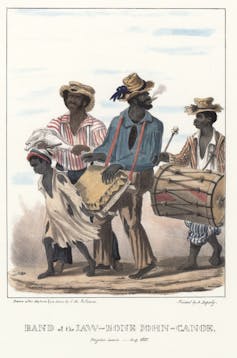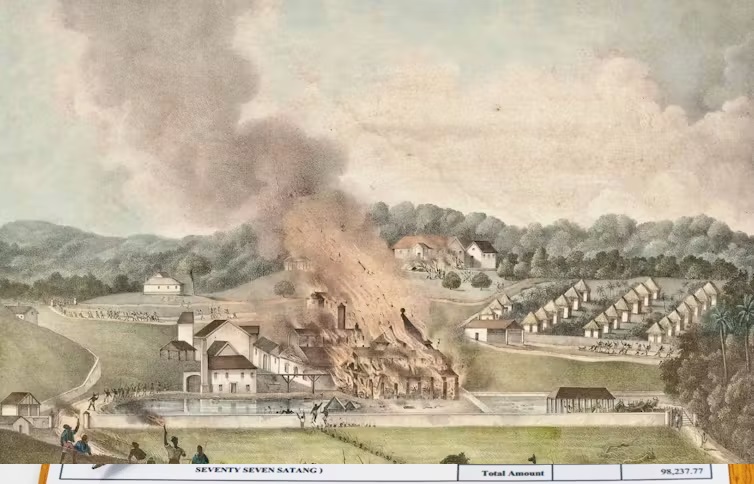Adolphe Duperly’s painting depicting the destruction of the Roehampton Estate in Jamaica during the Baptist War in January 1832. Wikimedia Commons
by Ana Lucia Araujo, Howard University
During the era of slavery in the Americas, enslaved men, women and children also enjoyed the holidays. Slave owners usually gave them bigger portions of food, gifted them alcohol and provided extra days of rest.
Those gestures, however, were not made out of generosity.
As abolitionist, orator and diplomat Frederick Douglass explained, slave owners were trying to keep enslaved people under control by plying them with better meals and more downtime, in the hopes of preventing escapes and rebellions.
Most of the time, it worked.
But as I discuss in my recent book, “Humans in Shackles: An Atlantic History of Slavery,” many enslaved people were onto their owners and used this brief period of respite to plan escapes and start revolts.
Feasting, frolicking and fiddling
Most enslaved people in the Americas adhered to the Christian calendar – and celebrated Christmas – since either Catholicism or Protestantism predominated, from Birmingham, Alabama, to Brazil.
Consider the example of Solomon Northup, whose tragic story became widely known in the film “12 Years A Slave.” Northup was born free in the state of New York but was kidnapped and sold into slavery in Louisiana in 1841.
In his narrative, Northup explained that his owner and their neighbors gave their slaves between three and six days off during the holidays. He described this period as “carnival season with the children of bondage,” a time for “feasting, frolicking, and fiddling.”
According to Northup, each year a slave owner in central Louisiana’s Bayou Boeuf offered a Christmas dinner attended by as many as 500 enslaved people from neighboring plantations. After spending the entire year consuming meager meals, this marked a rare opportunity to indulge in several kinds of meats, vegetables, fruits, pies and tarts.

Slavery Images
There’s evidence of holiday celebrations since the early days of slavery in the Americas. In the British colony of Jamaica, a Christmas masquerade called Jonkonnu has taken place since the 17th century. One 19th-century artist depicted the celebration, painting four enslaved men playing musical instruments, including a container covered with animal skin, along with an instrument made from an animal’s jawbone.
In the 1861 narrative of her life in slavery, abolitionist Harriet Jacobs described a similar masquerade in North Carolina.
“Every child rises early on Christmas morning to see the Johnkannaus,” she wrote. “Without them, Christmas would be shorn of its greatest attraction.”
On Christmas Day, she continued, nearly 100 enslaved men paraded through the plantation wearing colorful costumes with cows’ tails fastened to their backs and horns decorating their heads. They went door to door, asking for donations to buy food, drinks and gifts. They sang, danced and played musical instruments they had fashioned themselves – drums made of sheepskin, metal triangles and an instrument fashioned from the jawbone of a horse, mule or donkey.
It’s the most wonderful time to escape
Yet beneath the revelry, there was an undercurrent of angst during the holidays for enslaved men, women and children.
In the American South, enslavers often sold or hired out their slaves in the first days of the year to pay their debts. During the week between Christmas and New Year’s Day, many enslaved men, women and children were consumed with worry over the possibility of being separated from their loved ones.
At the same time, slave owners and their overseers were often distracted – if not drunk – during the holidays. It was a prime opportunity to plan an escape.
John Andrew Jackson was owned by a Quaker family of planters in South Carolina. After being separated from his wife and child, he planned to escape during the Christmas holiday of 1846. He managed to flee to Charleston. From there, he went north and eventually reached New Brunswick in Canada. Sadly, he was never able to reunite with his enslaved relatives.
Even Harriet Tubman took advantage of the holiday respite. Five years after she successfully escaped from the Maryland plantation where she was enslaved, she returned on Christmas Day in 1854 to save her three brothers from a life of bondage.
‘Tis the season for rebellion
Across the Americas, the holiday break also offered a good opportunity to plot rebellions.
In 1811, enslaved and free people of color planned a series of revolts in Cuba, in what became known as the Aponte Rebellion. The scheming and preparations took place between Christmas Day and the Day of Kings, a Jan. 6 Catholic holiday commemorating the three magi who visited the infant Jesus. Inspired by the Haitian Revolution, free people of color and enslaved people joined forces to try to end slavery on the island.
In April, the Cuban government eventually smashed the rebellion.
In Jamaica, enslaved people followed suit. Samuel Sharpe, an enslaved Baptist lay deacon, called a general strike on Christmas Day 1831 to demand wages and better working conditions for the enslaved population.
Two nights later, a group of enslaved people set fire to a trash house at an estate in Montego Bay. The fire spread, and what was supposed to be a strike instead snowballed into a violent insurrection. The Christmas Rebellion – or Baptist War, as it became known – was the largest slave revolt in Jamaica’s history. For nearly two months, thousands of slaves battled British forces until they were eventually subdued. Sharpe was hanged in Montego Bay on May 23, 1832.
After news of the Christmas Rebellion and its violent repression reached Britain, antislavery activists ramped up their calls to ban slavery. The following year, Parliament passed the Slavery Abolition Act, which prohibited slavery in the British Empire.
Yes, the week between Christmas Day and New Year’s Day offered a chance to feast or plot rebellions.
But more importantly, it served as a rare window of opportunity for enslaved men, women and children to reclaim their humanity.

Ana Lucia Araujo, Professor of History, Howard University
Ana Lucia Araujo is a historian and Professor of History at the historically Black Howard University in Washington DC in the United States. She was trained in Brazil, France, and Canada, and holds a PhD in History and Social and Historical Anthropology (2007), and a PhD in Art History (2004). She specializes in the history and memory of slavery and the Atlantic slave trade and is interested in the visual and material culture of slavery. She is the author or editor of sixteen books, including Reparations for Slavery and the Slave Trade: A Transnational and Comparative History (Bloomsbury Academic, 2023, second edition), The Gift: How Objects of Prestige Shaped the Atlantic Slave Trade and Colonialism (Cambridge University Press, 2023), and Humans in Shackles: An Atlantic History of Slavery (University of Chicago Press, 2024). In the United States, her work has been supported by fellowships from the American Council of Learned Societies, the Institute for Advanced Study (Princeton, NJ), the Getty Research Institute (Los Angeles, CA), and the American Philosophical Society. She is a member of the International Scientific Committee of the UNESCO Routes of Enslaved Peoples Project (former Slave Route Project).
This article is republished from The Conversation under a Creative Commons license. Read the original article.

